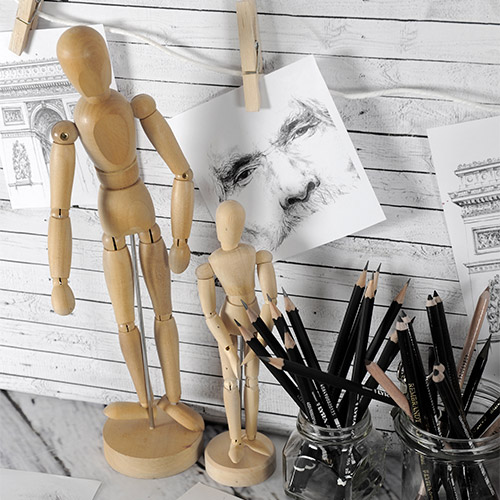One of the great advantages of drawing is that it requires very little preparation. A sudden inspiration? Just grab your pad and pencil, and give free rein to your imagination! However, there are a few aspects you shouldn't ignore.
- Home
- Expert advice
- Preparing your Drawing material

1. Attaching your paper
Paper, even heavy paper, is never completely stiff. It has to be supported.
Sketch books and drawing pads have built-in support. This is why they are recommended for beginners and drawing outdoors.
If you are working on a sheet of paper, you will need to attach it to a support first, to keep the paper from puckering or having your loose paper fly away!
There are several ways to support your paper:
- on a wooden or plywood drawing board, using drawing clips.
- a drawing board, using clips, thumbtacks or adhesive tape.

2. Preparing your working area
Improvising a home studio is easy: a work surface, good lighting, and you're all set! Outdoors, you need to use the D system.
2.1 Visual support:
A freestanding table is all you need for a fine workspace.
If you want to work on a tilted surface, use an easel or a table top easel. This will allow you to move easily and find the most comfortable way to hold your neck.
You can work however it suits you best, sitting or standing. Keep in mind that you need to be able to move about easily, to approach your subject, and, on the contrary, stand back from it. If you choose a sitting position, sit on a chair or a stool with wheels.
Outdoors, you can use your portfolio as the support. Note that there are also easels especially designed for outdoor work: portable easels.
2.2. Light
- Indoors, if you are right-handed, place yourself with the light to your left, to keep your hand from hiding it. Do the opposite if you are left-handed. If there isn't enough light, you can add desk lamps. Ideally, there should be one on each side of your work, each erasing the shadows cast by the other.
- Outdoors, wait till the last minute to add your shaded areas. Light changes fast and you could be destabilized by a complete change in luminosity.
Tip: an improvised easel.
Do you do large format work? Sit on a chair or stool, attach your sheet of paper to a drawing board and wedge iton your knees. Set the top of your board on the back of a second chair set in front of you. This gives you a stable surface with a tilt you can change anytime.
Recommended product:
C à grain® 180 & 224 g/m²
Explore more tutorials on this technique
Drawing
The basics of good inking
Drawing
Drawing a Christmas Pin-Up
Drawing
Composing Landscapes
Drawing
The travel album
Drawing
Composing a still life
Drawing
Paint and Draw Outdoors
Drawing
Drawing: Secrets of perspective
Drawing
Color Basics
Drawing
Eraser drawing
Drawing
Hatch drawing
Drawing
Drawing: Human proportions
Drawing
Drawing: Stumping
Drawing
Drawing a face
Drawing
Drawing a line
Drawing
Drawing: Determining proportions
Drawing
Architectural drawing
Drawing
Drawing: Selecting your material
Drawing
Choosing your drawing media
Drawing
Drawing: Create a sketchbook
Drawing
Select your drawing paper
Drawing
Drawing: shading and light
Drawing
The 6 essential steps in drawing
